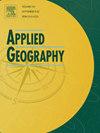Commuting behaviors response to living and working built environment: Dissecting interaction effects from varied supply and demand masses
IF 4
2区 地球科学
Q1 GEOGRAPHY
引用次数: 0
Abstract
Most developed megacities have experienced poly-centralization and suburbanization, leading to job-housing mismatches and negative outcomes such as increased commuting distances and frequencies. Recognizing the scarcity of structural analysis concerning the attractiveness of commuting's geographic endpoints, this study examines the diverse impact of the built environment at living and working locations on commuting flows, considering various supply-demand masses and distance levels. Utilizing a Gradient Boosting Decision Tree (GBDT) model, the study highlights the importance of job-housing ratio, POI diversity, and subway station proximity in employment locations, while informal area rates and subway proximity remain significant in residential locations. A three-dimensional analysis further indicates that achieving a perfect job-housing balance in megacities remains a dream, with each area presenting unique challenges requiring tailored solutions beyond a one-size-fits-all approach. Potential policies, such as planning large residential areas in the inner suburbs and upgrading convenient infrastructure in the outer suburbs, are proposed. Furthermore, with the uncovered distinct interaction effects of built environment on commuting behavior across various masses and distances, common perceptions related to mixed-use land and the role of informal settlement, are critically challenged. This extends our understanding of sustainable urban system design and provides references for planning policies.
通勤行为对生活和工作建筑环境的影响:剖析不同供需群体的互动效应
大多数发达大城市都经历了多中心化和郊区化,导致了工作与住房的不匹配以及通勤距离和频率增加等负面结果。由于缺乏对通勤地理终点吸引力的结构性分析,本研究考虑到不同的供需质量和距离水平,研究了生活和工作地点的建筑环境对通勤流的不同影响。利用梯度提升决策树(GBDT)模型,研究强调了就业地点的职住比、POI 多样性和地铁站邻近性的重要性,而居住地点的非正规区域率和地铁站邻近性仍具有重要意义。三维分析进一步表明,在特大城市实现就业与住房的完美平衡仍然是一个梦想,每个地区都面临着独特的挑战,需要量身定制的解决方案,而不能采用一刀切的方法。我们提出了一些可行的政策,如在内郊规划大型居住区,在外郊升级便利的基础设施。此外,由于发现了建筑环境对不同质量和距离的通勤行为的独特互动效应,与混合用途土地和非正规居住区的作用有关的常见观念受到了严峻的挑战。这拓展了我们对可持续城市系统设计的理解,并为规划政策提供了参考。
本文章由计算机程序翻译,如有差异,请以英文原文为准。
求助全文
约1分钟内获得全文
求助全文
来源期刊

Applied Geography
GEOGRAPHY-
CiteScore
8.00
自引率
2.00%
发文量
134
期刊介绍:
Applied Geography is a journal devoted to the publication of research which utilizes geographic approaches (human, physical, nature-society and GIScience) to resolve human problems that have a spatial dimension. These problems may be related to the assessment, management and allocation of the world physical and/or human resources. The underlying rationale of the journal is that only through a clear understanding of the relevant societal, physical, and coupled natural-humans systems can we resolve such problems. Papers are invited on any theme involving the application of geographical theory and methodology in the resolution of human problems.
 求助内容:
求助内容: 应助结果提醒方式:
应助结果提醒方式:


